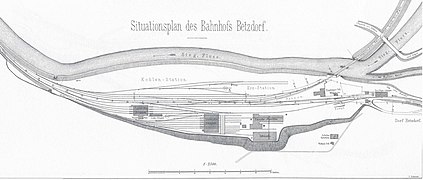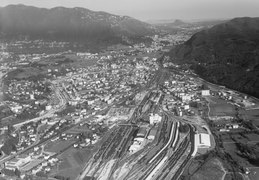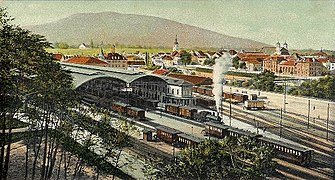Railway town

A railway town , without town charter, also a railway village, is a place that, as a result of the construction of important railway junctions , border stations or repair shops, has become much larger than it would have been without them. In such places, the railroad became extremely important in terms of urban development, cityscape and economic life. In some railroad towns, the importance of the railroad has meanwhile declined sharply.
This is to be distinguished from railway settlements, which were completely redesigned on the green meadow, similar to factory settlements, as a place of residence for railway employees and their families.
Characteristic
Railway towns have developed from older places or have been founded in the course of industrialization , in Central Europe primarily in the 19th century. In railway towns, the supra-regional importance of passenger and / or freight traffic resulted in a major change in urban development, the number of inhabitants, the cityscape and general economic life.
Due to their dependence on the railway, railway towns are prone to changes in the railway structure, for example through the construction of new high-speed lines with a different route, for automation in goods handling or for the dismantling of border controls, for example through the Schengen Agreement . Cerbère and Portbou on the French-Spanish border are examples of former railroad towns that have lost their importance completely due to the above changes .
Examples
Germany
Railway towns due to traffic junctions are Aulendorf , Bebra , Betzdorf , Buchloe , Falkenberg / Elster , Hagen , Hamm , Lehrte , Offenburg , Plattling and Treuchtlingen . Railway towns as locations of railway depots for push locomotives at the foot of inclined lines are Altenhundem or Neuenmarkt . Railway towns with large border stations are Freilassing or Weil am Rhein .
- Railway towns in Germany
Austria
Knittelfeld is a railway town based on main workshops , with the Austrian Federal Railways as by far the largest employer . In Arnold Stein was once an important border station to Italy.
Switzerland
Examples in Switzerland are Olten or, as the location of a railway depot for push locomotives, Erstfeld . One place with a large border station is Chiasso .
France
Examples of railway cities in France are Tergnier and Miramas . Examples of a railway town through its border station is Cerbère , where the rails of the Spanish broad gauge end.
- Railway locations in Switzerland and France
Chiasso,
view over the Swiss-Italian border to Como with the lake 1962Erstfeld,
Switzerland
View towards Gotthard
Belgium
In Belgium, the town of Montzen is of outstanding importance in rail traffic.
Luxembourg
Thanks to its marshalling yard and other railway facilities on the international Brussels / Amsterdam - Luxembourg - Metz route , Bettembourg gained great importance in transit traffic through Luxembourg.
Poland
After the First World War , the city of Bentschen (Zbąszyń in Polish ) fell from the German Empire to Poland. It was subsequently by the German Reichsbahn the station Zbaszynek established, the functions as a border station and the hub set up for three leading west routes. Since there was no large town near the new train station, the Deutsche Reichsbahn had a railway settlement built, which subsequently grew into a town. It was named Neu Bentschen (Polish: Zbąszynek) .
Portugal
An example of a railway town in Portugal is Entroncamento .
Romania
Simeria in Romania grew into the city with new railway systems.
Czech Republic
After the First World War , the Austro-Hungarian monarchy disintegrated and the state of Czechoslovakia emerged . In 1920, Czechoslovakia was granted a few more border areas in Austria , including the train station in the Lower Austrian city of Gmünd with the surrounding district. From this the new town of České Velenice developed . The background to the demarcation was the meeting of the railway lines to Budweis and Prague in České Velenice.
coat of arms
The importance of the railway can also be seen in the railway symbols in the municipal coats of arms. Neuenmarkt and Aulendorf have an impeller . Bebra has crossed railway tracks in its coat of arms, which symbolize the two crossing railway lines and the crossing station .
literature
- Werner Mikus: The effects of a railway junction on the geographical structure of a settlement: using the special example of Lehrte and a comparison with Bebra and Olten / Switzerland. In: Freiburger Geographische Hefte. Book 3. (Zugl .: Diss. Univ. Freiburg 1966): Freiburg 1966.









